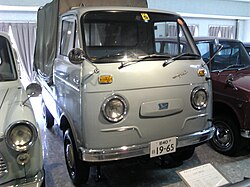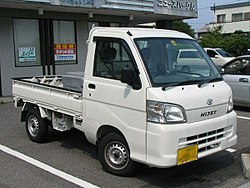Daihatsu Hijet
| Daihatsu Hijet | |
|---|---|
| Manufacturer: | Daihatsu |
| Production period: | 1960 – today |
| Previous model: | none |
| Successor: | none |
Daihatsu Hijet is a range of small vans from the Japanese manufacturer Daihatsu .
history
The Hijet originally came onto the market as a pick-up in 1960 and has been built as a chassis with a flatbed structure since 1965 . From 1972 it was also built as a panel van and minibus , on the basis of which the Van Daihatsu Atrai was created. The Hijet Jumbo was presented for the first time in the 1980s . The engine range originally began with air-cooled 2-cylinder petrol engines . This was followed by electric motor , diesel engine , natural gas vehicle up to the hybrid drive .
From 1977 the Hijet was also offered in Europe. Due to the strong appreciation of the yen and the accompanying decline in exports, Daihatsu stepped up its efforts to produce its vehicles locally. For example, Piaggio from Italy produced the Hijet in Europe for Daihatsu from November 1992 to February 2002. Since then it has been built as the Piaggio Porter . In South Korea , Asia Motors built the Hijet as a Towner under license. In addition to other Asian countries, the Hijet was also exported to South America and the People's Republic of China .
Today it is built in China by Liuzhou Wuling Motors and Tianjin Automobile . In Indonesia , the current model has been built by Astra Daihatsu Motor since 2008 and imported to Japan, as has the Toyota Pyxis since December 2011 and the Subaru Sambar since April 2012, both of which are based on the current Hijet.
Daihatsu New Line / Hijet L35 / L36 (1960–1967)
| Hijet L35 / L36 | |
|---|---|
|
Hijet L35 / L36 |
|
| Production period: | 1960-1967 |
| Body versions : | Pickup truck |
| Engines: |
Otto engine : 0.36 liters |
| Length: | 2995 mm |
| Width: | 1295 mm |
| Height: | |
| Wheelbase : | |
| Empty weight : | |
In November 1960, the Hijet L35 with the air-cooled petrol engine type ZM L35 with 360 cm³, 3-speed manual gearbox and rear-wheel drive came onto the market as a truck version of the platform truck with two seats. In May 1961, the panel van was presented, which was just a pick-up with a tarpaulin body . Some changes were made in November 1965. A water-cooled 800 cc 4-stroke OHV engine with a 4-speed manual gearbox was also offered. In October 1966 the air-cooled engine type ZM L35 was replaced by the now water-cooled two-stroke two-cylinder type L36 ZM. In 1967 the L35 / L36 was replaced by the Daihatsu Fellow .
Daihatsu Hijet S 35 / Hijet New Line Cab (1964–1968)
| Hijet S35 | |
|---|---|

Hijet S35 Cab |
|
| Production period: | 1964-1968 |
| Designs: | Pickup truck |
| Engines: |
Petrol engines : 0.36-0.8 liters |
| Length: | 2995 mm |
| Width: | 1295 mm |
In April 1964, the S35 was introduced as the Hijet Cab and Hijet New Line Cab . The Hijet Cab was a flatbed truck, optionally with a tarpaulin structure with the ZM engine with 360 cm³ and air cooling. The Hijet New Line Cab was a reinforced chassis with various possible superstructures and had a water-cooled ZM engine with 800 cm³. Both models had 4-speed manual transmissions and suicide doors . In October 1966 the ZM engine with 360 cm³ was converted to water cooling throughout the company. In 1968 the Daihatsu Delta replaced the Hijet New Line Cab.
Daihatsu Hijet S37 (1968–1972)
| Hijet S37 | |
|---|---|

Hijet S37 |
|
| Production period: | 1968-1972 |
| Designs: | Pickup truck |
| Engines: |
Otto engines : 0.36 liter electric motor |
| Length: | 2995 mm |
| Width: | 1295 mm |
In April 1968 the Hijet S37 was introduced. This was a thoroughly revised S35 body with the water-cooled 360 cm³ ZM engine and 4-speed manual transmission. The headlights were now square and the indicators were now mounted above the bumper. There were now front-hinged doors. An electric motor was also offered for a short time .
Daihatsu Hijet S38 / S40 (1972–1981)
| Hijet S38 | |
|---|---|

Hijet S38 panel van |
|
| Production period: | 1972-1972 |
| Designs: | Flatbed trucks , box trucks |
| Engines: |
Petrol engines : 0.36–0.55 liters |
| Length: | 2995-3195 mm |
| Width: | 1295 mm |
The S38 series appeared in February 1972. For the first time a van called a van was available. This had a tailgate and two sliding side doors and offered space for four people. The drive was again taken over by the ZM type 2 two-stroke 2-cylinder engine with 360 cm³ and 4-speed manual transmission.
In September 1974 the front was slightly redesigned and the 360 cc petrol engine was adapted to the current emissions regulations . From April 1976 a 550 cc 2-cylinder four-stroke engine type AB was available as the Hijet S40. The length of the van grew by 200 mm, that of the truck by 50 mm. In April 1979 all models received the radiator grille of the Hijet S60 and the lettering Hijet on the front hood. In addition, the dashboard has been redesigned. In April 1980, the S40 with 550 cm³ was discontinued due to the changed driving license guidelines for Kei-Cars . The S38 with 360 cm³ was produced until August 1981. The 500,000th Hijet was also produced in 1980.
Daihatsu Hijet S60 / Daihatsu Hijet Wide 55 (1977–1981)
| Hijet S60 / Hijet Wide 55 | |
|---|---|

Hijet S60 / Hijet Wide 55 bus |
|
| Production period: | 1977-1981 |
| Designs: | Flatbed trucks , panel vans , minibuses |
| Engines: |
Otto engine : 0.55 liters |
| Length: | 3195 mm |
| Width: | 1395 mm |
| Height: | 1625 mm |
| Wheelbase: | 1815 mm |
The Hijet S60 was developed based on the S38 / S40 van and was first exported as the Hijet Wide 55. Compared to the S38 / S40, the S60 was 100 mm wider. He only had the 550 cc two-cylinder four-stroke engine type AB20 with a 4-speed manual gearbox with a rigid rear axle and leaf springs . It was available as a panel van or minibus with up to six seats or as a flatbed truck. The S60 had four hydraulically operated drum brakes without brake booster. Tire size 5.00-10 / 6PR. Permissible trailer load: braked 600 kg. The empty weight is given as 700 kg.
In April 1979 the dashboard and the interior were heavily redesigned. A high-roof version was also available from 1980.
Daihatsu Hijet S65 / S66 (1981–1986)
| Hijet S65 / Hijet S66 | |
|---|---|

Hijet S65 |
|
| Production period: | 1981-1986 |
| Designs: | Flatbed trucks , panel vans , minibuses |
| Engines: |
Otto engine : 0.55 liters |
| Length: | 3195 mm |
| Width: | 1395 mm |
| Height: | 1870 mm |
| Wheelbase: | 1810 mm |
The Hijet S65 was launched in April 1981. It was basically a heavily redesigned S60. A van (automobile) , the Daihatsu Atrai, was developed based on the van / minibus . Only the 550 cm³ petrol engine was now available, but the transmission was optionally supplemented with a track-road mode option (low gear). In March 1982 the S66 model appeared with switchable all-wheel drive as standard , which eliminated the track-road mode option for the manual transmission. In October 1983 the Hijet Jumbo (S65P) appeared, a pickup with an increased payload, standard front disc brakes and optional freewheel hubs.
Daihatsu Hijet S80 / S81 (1986-1994)
| Hijet S80 | |
|---|---|

Hijet S80 |
|
| Production period: | 1986-1994 |
| Designs: | Flatbed trucks , panel vans , minibuses |
| Engines: |
Gasoline engine : 0.55–1.0 liters |
| Length: | 3195-3295 mm |
| Width: | 1395 mm |
| Height: | 1870 mm |
| Wheelbase: | 1810 mm |
In May 1986 a completely new model appeared with the S80. The standard engine was now the three-cylinder engine EB with 550 cm³, optionally also with a compressor . A 660 cm³ engine was now also available as an option. A 986 cm³ engine was used for export. A 3-speed automatic transmission was also available for the 2WD vehicles on request . The vehicle, which stood on 10-inch wheels, had a turning circle (vehicle) of only 8.5 meters. With switchable all-wheel drive, the model became the S81 and then had 12-inch tires. In September 1987 there was an optional air conditioning system . Minor changes were made in October 1988. From April 1990, front disc brakes were fitted as standard on the 4WD model and the 660 cm³ engine received a revision. In March 1992 the automatic transmission was also available for the 4WD models and the front was redesigned. Disc brakes were now standard on all models as well as a catalytic converter and 5-speed manual transmission. The curb weight is given as 830–850 kg.
Asia Motors / Kia Towner
From 1991 the Hijet S80 was also produced by Asia Motors , later Kia Motors , under license as Asia / Kia Towner .
Piaggio
From November 1992 to February 2002 the Hijet S80 was produced by Piaggio for Daihatsu in Italy. In addition to the well-known petrol engines, there were now also 1.3-liter and later 1.4-liter diesel engines . In 2002 Daihatsu Europe went bankrupt and the sale of the Hijet in Europe ended. Since 2003, Piaggio has been building the Piaggio Porter based on the Hijet S80 and under license from Daihatsu.
Daihatsu Hijet S100 / S110 (1994-1999)
| Hijet S100 | |
|---|---|

Hijet S100 |
|
| Production period: | 1994-1999 |
| Designs: | Flatbed trucks , panel vans , minibuses |
| Engines: |
Otto engine : 0.66 liter electric motor |
| Length: | 3295 mm |
| Width: | 1395 mm |
| Wheelbase: | 1900 mm |
Daihatsu Hijet S200 / S210 (since 1999)
| Hijet S200 | |
|---|---|

Hijet S200 |
|
| Production period: | 1999-2004 |
| Designs: | Flatbed trucks , panel vans , minibuses |
| Engines: |
Otto engine : 0.66 liter electric motor |
| Length: | 3395 mm |
| Width: | 1495 mm |
| Wheelbase: | 1900-2400 mm |
Daihatsu Hijet S320V / S321V (since 2004) and Toyota Pyxis (since 2011)
| Hijet S320V / Hijet S321V | |
|---|---|

Hijet S320V |
|
| Production period: | 2004 – today |
| Designs: | Panel van , minibus |
| Engines: |
Petrol engine : 0.66 liter petrol hybrid |
| Length: | 3395 mm |
| Width: | 1475 mm |
| Wheelbase: | 2400 mm |
Web links
Individual evidence
- ↑ Archive link ( Memento of the original from December 17, 2015 in the Internet Archive ) Info: The archive link was inserted automatically and has not yet been checked. Please check the original and archive link according to the instructions and then remove this notice.
- ↑ Daihatsu Motors: Parts Catalog: Daihatsu Hijet Wide 55 S60 . 1981, p. 1 .
- ↑ Data according to my vehicle registration document and the operating instructions









